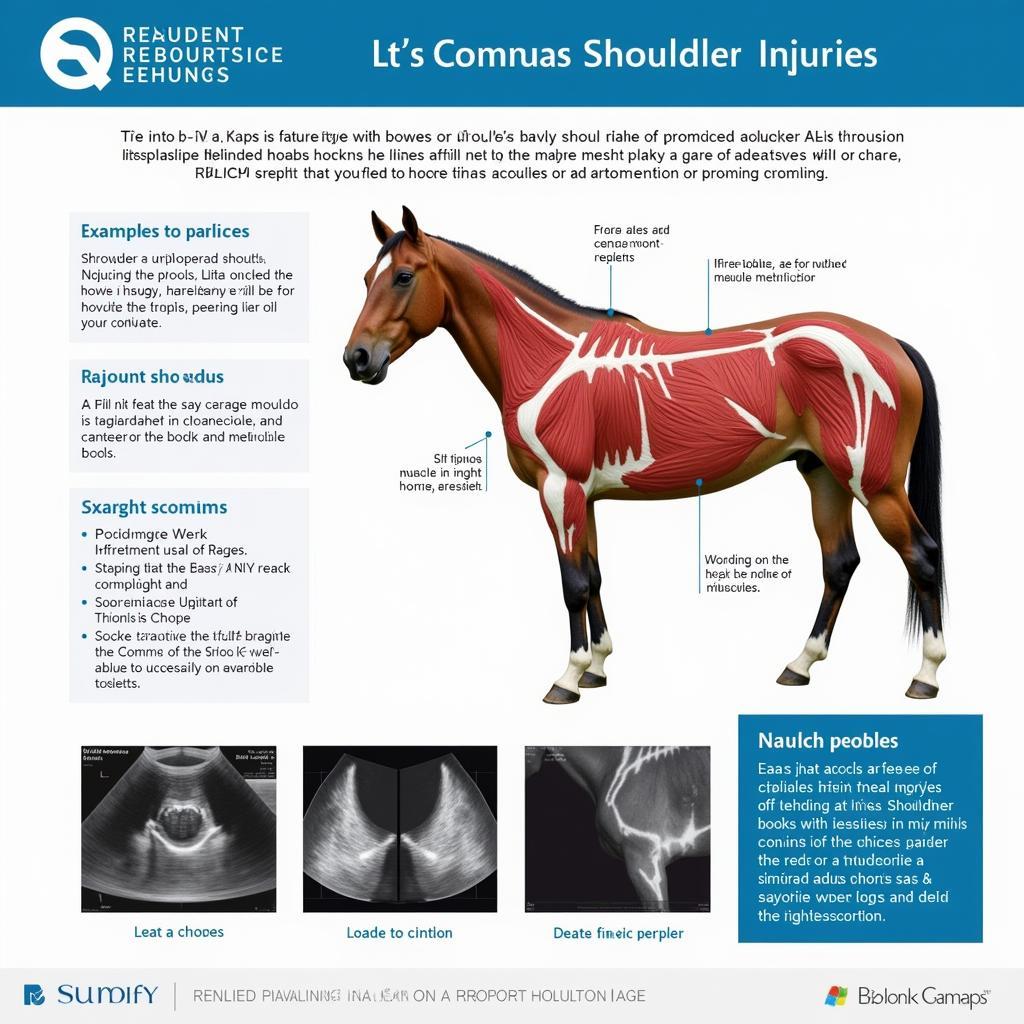The Horse Shoulder Muscles are a complex and fascinating network of power and precision, essential for movement, balance, and athletic performance. Understanding their anatomy and function is crucial for any horse owner or enthusiast. Let’s dive deep into the equine shoulder, exploring its key muscles and their roles.
Major Muscles of the Equine Shoulder
The horse’s shoulder, unlike humans, doesn’t have a collarbone. Instead, a powerful system of muscles connects the forelimb to the body, allowing for a remarkable range of motion. These muscles can be broadly categorized into extrinsic and intrinsic muscles. Extrinsic muscles connect the limb to the body, while intrinsic muscles are located entirely within the limb itself.
- Brachiocephalicus: This large, prominent muscle runs from the head to the humerus, contributing significantly to forward movement and extending the foreleg.
- Trapezius and Rhomboideus: These muscles support the shoulder blade and are crucial for lifting and rotating the scapula.
- Omotransversarius: This muscle runs from the wing of the atlas (a bone in the neck) to the shoulder, assisting in pulling the leg forward.
Want to learn more about the neck region? Check out our article on horse neck anatomy.
Deep Shoulder Muscles
Beneath the more superficial muscles lies another layer of essential muscles. These include:
- Supraspinatus and Infraspinatus: These muscles stabilize the shoulder joint and play a vital role in extending and rotating the humerus.
- Subscapularis: This muscle is located on the underside of the scapula and is involved in adducting the forelimb (moving it towards the body).
- Deltoideus: Located on the lateral aspect of the shoulder, the deltoideus flexes the shoulder joint and assists in protraction (moving the leg forward).
- Pectorals: These muscles, both superficial and deep, contribute to adduction and movement of the forelimb.
Why Understanding Horse Shoulder Muscles Matters
Understanding the horse shoulder muscles is essential for several reasons:
- Performance: Proper muscle development and function are crucial for optimal athletic performance.
- Injury Prevention: Knowing the anatomy can help prevent and identify injuries.
- Rehabilitation: Understanding muscle function is key to effective rehabilitation after injury.
- Saddle Fitting: A well-fitting saddle considers the shoulder’s movement and avoids restricting these crucial muscles. A good horse quarter sheet can also help protect the shoulder area.
A visual aid can be incredibly helpful in understanding the complexity of equine anatomy. Check out our horse anatomy poster for a detailed overview.
Dr. Emily Carter, DVM, Equine Sports Medicine Specialist, states, “The shoulder is a complex area, and understanding its intricacies is essential for maintaining a horse’s soundness and maximizing performance.”
 Horse Shoulder Muscle Injury: Common injuries affecting the horse's shoulder, including strains, tears, and inflammation, along with their symptoms and treatment options.
Horse Shoulder Muscle Injury: Common injuries affecting the horse's shoulder, including strains, tears, and inflammation, along with their symptoms and treatment options.
Conclusion
The horse shoulder muscles are a remarkable example of natural engineering, allowing for the grace and power we admire in these animals. By understanding their anatomy and function, we can better care for our equine partners and ensure their long-term health and well-being. Remember, a healthy shoulder is crucial for a happy horse. Keeping your horse warm during colder months can help prevent muscle stiffness. Consider a horse jacket for extra protection.
Training with long lines horse can also be beneficial for developing shoulder muscles.
FAQ
- What are the main functions of the horse’s shoulder muscles? They primarily facilitate movement, balance, and support of the forelimb.
- How can I help prevent shoulder injuries in my horse? Proper conditioning, warm-up, cool-down, and a well-fitting saddle are essential.
- What are the signs of a shoulder injury in a horse? Lameness, stiffness, swelling, and reluctance to move are common indicators.
- How are horse shoulder injuries diagnosed? Veterinarians use physical exams, palpation, and sometimes imaging techniques like ultrasound or X-rays.
- What is the importance of the brachiocephalicus muscle? It’s crucial for forward movement and extending the foreleg.
- How do the supraspinatus and infraspinatus muscles work together? They stabilize the shoulder joint and contribute to extension and rotation of the humerus.
- Why is understanding shoulder anatomy important for saddle fitting? A poorly fitting saddle can restrict shoulder movement and lead to discomfort and injury.
Need assistance? Contact us at Phone Number: 0772127271, Email: [email protected] Or visit us at QGM2+WX2, Vị Trung, Vị Thuỷ, Hậu Giang, Việt Nam. We have a 24/7 customer service team.